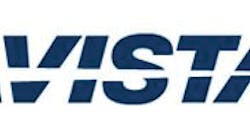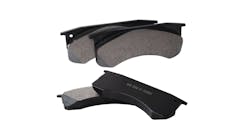I was warned in my safety screening ahead of getting behind the wheel that there may very well be wildlife crossing the track. Brian Jacquay, director of operations for Navistar’s proving grounds, wasn’t kidding. The first loop, driving the first truck of the day, I nearly took out a turkey crossing the three-lane, three-mile track. I can confirm the air brakes on the new International LT Series are in good working order.
That’s not to mention some of the other notable features and functionality the company has undertaken on it’s latest Class 8 product, launched in late 2016.
I had the chance to drive five different International Trucks during my visit, including two LT Series trucks – one specified with the company’s latest powertrain offering, the International A26 12.4L engine, and one specified with a Cummins X15 engine; an HX Series heavy duty dump truck; an MV Series Class 6 chassis; and a CV Series light duty chassis.
Details on proving grounds
Before getting started for the day, Jacquay gave a brief history of the proving grounds and provided some safety guidelines (including the apropos suggestion to keep an eye out for the occasional bird or deer with a death wish).
Located in New Carlisle, Indiana, the proving grounds were originally built by Studebaker in 1925 to test vehicles off the production line in nearby South Bend. Bendix purchased the site in 1963, and it changed hands through a number of company acquisitions before being managed by Bosch in the 1990s. Navistar purchased the grounds in 2015.
The 675-acre grounds currently has two test tracks: a three-mile, three-lane oval route, and a durability route for testing dump trucks and worksite equipment. Jacquay confirmed they’re also constructing a third track on 40 acres in the center of the oval route for lower speed testing, such as vehicle safety systems and automated systems.
The Navistar Proving Grounds are open to outside companies and can also be rented by other organizations looking to test their own equipment – anything from bikes to military equipment. Commercial vehicle component or system manufacturers to competitive truck OEs have rented out the facility for their own testing. Jacquay mentioned about 50 percent of the testing completed at the track is external.
General improvements and noticeable differences for LT Series
First up, I got behind the wheel of the LT Series Class 8 with the International A26 12.4L engine, mated with the Eaton Endurant 12-speed automated manual transmission (AMT). About 45 seconds into the drive, I nearly took out a turkey crossing the track, slowing from 50 to 25 miles per hour.
Immediately following that drive, I took the LT Series with the Cummins X15 engine, also mated with the Eaton Endurant 12-speed, to compare the two.
For the LT Series drives, I pulled a flatbed hauling solid cement blocks weighing in at 3,000 pounds each. We hauled 13 blocks (39,000 lbs) on the LT Series with the A26 and 9-1/2 blocks (28,500 lbs) on the LT Series with the Cummins X15.
Navistar's Jim Nachtman provided me an overview of the product lines, and sat in the cab during the test drives. He's been with the company 17 years and is currently product marketing director for the company's LT Series, RH Series, and LoneStar heavy duty product lines, as well as the International A26 12.4L engine. He comes from the engineering side and was actually the design engineer for the A26.
Inside the cab, it was noticeably quiet operating at highway speeds. Nachtman confirmed updated noise dampening features in the cab, including insulation and one-piece side windows. This is in addition to the quieter operation of the International A26 engine itself. (The Cummins engine was just a bit louder, but not enough to be so.)
I also noted some of the improvements to driver comfort. I measure in at a towering 5 feet, 4-1/2 inches. I won’t name names, but there was a particular truck I drove during my truck driving class, from another OE, that had me on the edge of my seat (literally) to reach the clutch brake when stopped. I had no such problem with the LT Series, and that's not just because there’s, well, no clutch pedal to speak of… I could reach the treadle valve (err, brake pedal) and accelerator easily, and could make adjustments to both the air ride seat and steering wheel position. Plus, I could easily see out the windshield and keep my head on a swivel to check the mirrors. Nachtman noted the mirrors were positioned farther forward than previous models, so drivers aren’t craning their necks as far. Not a noticeable strain for the 15 minutes I was behind the wheel, but that could certainly help after 11 hours of driving.
Comparing the two trucks in operation, especially at initial acceleration, the A26 seemed to be mated more optimally with the Eaton Endurant 12-speed transmission. The AMT shifting was hardly noticeable and the engine noise was much quieter than many trucks I've driven.
Having learned to drive manual, I prefer to shift myself. But with spec'ing rates of AMTs rising substantially industry-wide over the last few years, it’s something all drivers will inevitably need to get used to. Case in point, Nacthman confirmed over the last year upwards of 90 percent of International LT and RH Series had been specified with an AMT. I will say, the latest AMTs continue to improve upon the algorithms to optimize shifting patterns and mating of engines. Both LT Series trucks - with the A26 and the Cummins X15 - run much more smoothly with AMTs compared to any predecessors I’ve driven.
Looking under the hood
The International A26 replaces the company’s N13 engine. It weighs in at 2,299 lbs – a 600-lb weight reduction compared to the Cummins X15.
Looking under the hood at the A26 there were a few items that Nachtman pointed out that aid in more efficient servicing of the vehicle.
Notably, the A26 has some similar design attributes to the European MAN D26 and D38 15L engines. That’s because both share the same high-pressure common rail fuel system design. This was made possible through Navistar’s strategic alliance with Europe-based commercial vehicle manufacturer Traton (previously known as Volkswagen Truck & Bus). Traton owns a near 17 percent stake in Navistar and is the commercial vehicle division of Volkswagen Group. Traton manages the MAN and Scania brands, among others.
There are six fan blades in the A26 compared to nine fan blades in the X15. Fewer blades means less noise while still creating the same amount of power, says Nachtman. This additional power on the A26 is transferred to the rear axles.
New larger piston pins, connecting rods and bushings account for the additional durability needed for the engine. “What that means is we can operate the engine with higher pressures for better fuel economy,” Nachtman explains. “They’re also designed to be the same parts for the next generation of A26 – for EPA 2021 compliance.”
Conversely, piston cooling jets have been made smaller to increase oil pressure flow. This allows the engine to operate at lower rpm while maintaining the same vehicle speed, also referred to as downspeeding. “Smaller piston cooling jets raise the oil pressure, so you can lower the engine speed more and still have all the lubrication necessary for durability,” Nachman says. He confirms the lowest downspeeding rating for the A26 is 975 rpm. Typical cruising speed would be about 100 to 200 rpm higher for most applications. Plus, less oil subjected to the hot pistons helps reduce oxidation. That translates to extending oil change intervals.
Nachtman noted a number of other underhood components with improved ease of access. For instance:
- Prescribing to the adage “if it ain’t broke, why fix it,” the EGR cooler is the tried and true design of previous International engine models. The OE spec features a single-stage, self-cleaning design.
- The variable geometry turbocharger, from Borg Warner, features a serviceable electronic actuator. “If you need to replace a circuit board, for example, you can leave the expensive and heavy turbo in place,” says Nachtman. “Remove four bolts and put a new actuator on. You’re back on the road."
- The cartridge-style fuel and oil filters offer quicker removal and installation.
- The wheel well in front of the drive tires and front fairing has more access for technicians if they’re trying to get in between to access the engine.
- The aftertreatment system is improved compared to other brands, says Nachtman. Accessibility of the system is through the removal of the four bolts on the passenger side steps to remove the side fairing. The one-slide canister provides easy access to the diesel oxidation catalyst (DOC) and diesel particulate filter (DPF). To remove the filters, techs would simply take off the two V-brackets to access the system.
Lest we forget the move toward computers on wheels, technology played a big role in the design – this includes over-the-air cellular update capabilities to change engine parameters remotely (coming later in 2019) and improvements to the engine control module (ECM) allowing for the elimination of a separate module at the bottom of the cab to run the aftertreatment system.
“We were able to eliminate that module, take the software and put it into the engine control module,” Nachtman explains. “One of the biggest gremlins in the Class 8 industry is electrical issues, regardless of OEM. They happen, they’re difficult to diagnose, they’re difficult to get replacement harnesses. It’s just an industry issue. By getting rid of that module and all that wiring, it’s a lot better for uptime.”
Future product outlook
No one likes to rehash the past. But it’s important to understand how far the company has moved forward since its “fumble” in technology adoption more than a decade ago.
For those that need a refresher, Navistar took the solo route of putting its eggs in one basket with advanced engine gas recirculation (EGR) technology. The company had foregone – at least initially – implementing select catalytic reduction (SCR) technology altogether. (You all know and love it as the system that requires DEF.) It cost them the ability to initially meet U.S. EPA 2010 on-highway GHG engine emissions standards.
SCR technology, as we’re all well aware, is used predominantly in all commercial vehicle heavy duty engines today – including the International A26.
Overall, things appear to be looking up for the company as it continues to introduce new technologies on trend with the others in the industry.
Nachtman says a lot of those conversations have passed from discussing previous engine issues now to general industry-wide pain points, such as access to parts.
They’ve made believers out of fleets willing to try out the latest International Truck offerings, and out of other industry organizations. Case in point: the strategic partnership established with Traton, mentioned earlier.
Nachtman says early feedback from customers on the International A26 engine has been positive. “We’ve been getting a lot of repeat orders,” he says. “Repeat orders are a good indication of how the product is performing. If you bought the first one, you ran it, you liked it, you buy more and you continue to buy more.”
He advised the highest operating mileage for the A26 so far has reached 350,000 miles. Nachtman says that engines with the higher mileage have sold fleets on subsequent orders. “The ones on the high mileage sold the second batch, sold the third batch. It’s an indication that the early built units are performing extremely well and customers are loyal to the product.”
In the Driver’s Seat is a blog series from Fleet Maintenance editor-in-chief Erica Schueller, documenting her driving experience. For more updates from the road, follow her on Twitter and Instagram.





